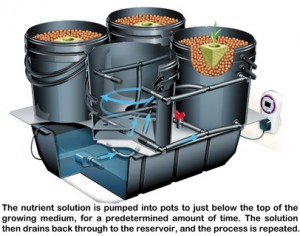The nutrient solution within a hydroponic reservoir should always be full with a larger container (for extra space) that has a lid to lessen evaporation. Depending on the size and environment of your garden, on average, it will use 5 – 25 percent of nutrient solution a day.
Large volumes of nutrient solution in your hydroponic reservoir will help to minimize any nutrient imbalances and give more buffering if you add too much nutrient to the reservoir.
Always check the level of your hydroponic reservoir every day and top it off with either water or nutrients if necessary. Using up as much nutrient solution before changing it out will help you save money since you will not be draining it all out and down the drain.
Pumps on hydroponic reservoir systems should be set up to lift the solution out of the reservoir. By setting the reservoir high enough you can easily siphon or gravity flow it into a drain or to an outdoor garden.
Hydroponic Reservoir Temperature
The temperature of nutrient solution should always stay between 60 – 75° F (15 – 24° C) for plants to readily take the nutrients up and not shock the plants. Water holds more oxygen when the temperature is at 60° F (15° C) than it will at 75° F (24° C).
Heat nutrient solution is better than heating the air in a room since the reservoir will radiate the heat out and provide the room with warm air (though it may not be fast or enough to heat the room).
A temperature above 85° F (29° C) in the nutrient solution holds little oxygen and can easily damage plant roots.
The nutrient solution that has a temperature around 60° F (15° C) will help you to control transpiration and humidity within the room while also promoting more nutrient uptake for plants. An air pump submerged in the hydroponic reservoir will aerate the solution and help the temperature to level out.
Irrigation With A Hydroponic Reservoir
Irrigation is something that will depend upon many things and must be adjusted to your garden since one setup will not always work for every garden. Irrigation cycles depend on plants’ size, climate conditions, and the type of growing medium that is being used.
Mediums that are easily drained will need watering more often than others like vermiculite. Top-feed systems generally cycle for about five (5) minutes or longer and are irrigated at least three (3) times a day.
For fast-draining mediums, overhead irrigation is continually cycled twenty-four (24) hours a day. During and after irrigation the nutrient concentration between the bed and reservoir should be at the same concentration.
If enough time passes between cycles, they may be different and by experimentation, you will be able to find out more so you will be able to make adjustments.
Nutrient Disorders w/ Hydroponic Reservoirs

When the hydroponic garden is regularly maintained and the grower knows the crop well, most nutrient problems can be averted.
If nutrient deficiencies or excesses occur in your system to one or more plants, check irrigation fittings and tubing to make sure that they are connected properly with no kinks disrupting the nutrient flow.
This will ensure that nutrient-challenged plants are being properly fed. Be sure drainage channels are not plugged or sitting in a stagnant solution since this will rot roots rapidly.
When checking the root system be sure to check the pH to make sure it is within the 5.5 – 6.5 range in the hydroponic reservoir. If there is a nutrient disorder and changing the solution does not solve the problem then try changing to a new brand of fertilizer.
The treatment for nutrient deficiencies or excesses must be taken care of immediately since hydroponic systems do not have a buffer and the deficiencies or excess can affect your plants very quickly. Nutrient deficiencies or excesses diagnosis is rather difficult when two (2+) or more elements are deficient or excessive at the same time.
Taking care of over-fertilization is easy by flushing the system twice (2) with fresh dilute (5 – 10 percent) nutrient solution and this should take care of more problems. Nutrient disorders affect a plant strain at the same time as other plants of the same strain so the nutrient solution is due to being identical in how it affects the plants.
Different plant varieties will often react differently to the same nutrient solution. When you are growing one plant strain in a hydroponic reservoir system is often easier to fix than having multiple plant strains within a system.
Let us know what you think.







Responses